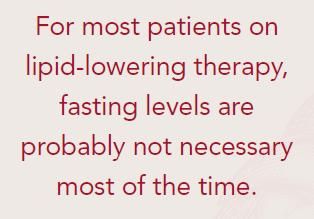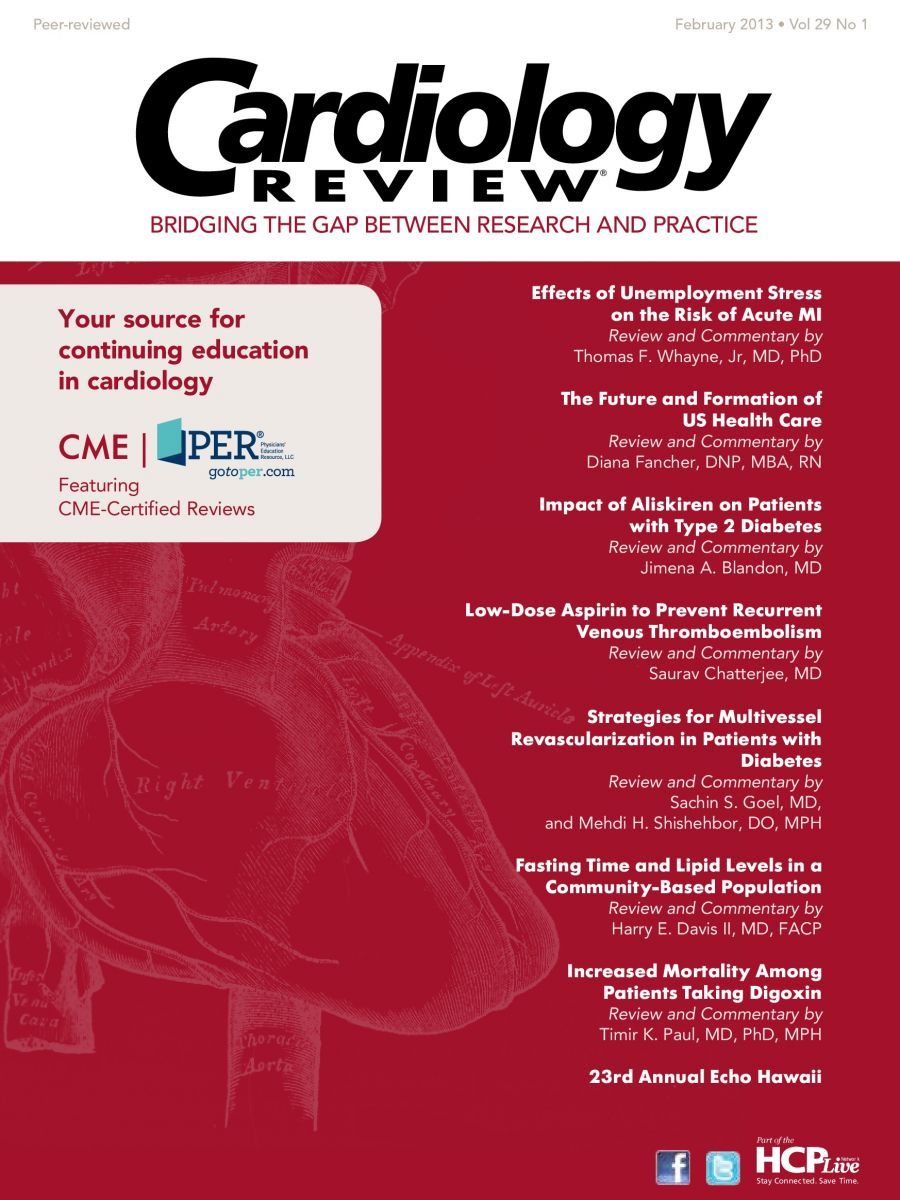Publication
Article
Cardiology Review® Online
Fasting Time and Lipid Levels in a Community-Based Population

Harry E. Davis II , MD, FACP
Review

Most guidelines for the evaluation of lipid levels call for obtaining a fasting specimen for analysis. It has been assumed that the potential for significant variability in nonfasting patients would preclude meaningful analysis of the results. Upon review of the basis for this assumption, Sidhu and Naugler at the University of Calgary in Alberta, Canada, found evidence to suggest the measurement of nonfasting lipids could provide clinically valid information and might be useful in predicting cardiovascular disease risk.
Study Details
Due to a change in laboratory policy in early 2011, Calgary Laboratory Services (CLS) was allowed to process samples for fasting lipid levels as long as the duration of fasting time (in hours) was recorded and included in the laboratory report.1 As the sole supplier of laboratory services for Calgary, this policy change provided an opportunity to examine the variability of lipid levels associated with the duration of fasting in a large community-based population. Sidhu and Naugler collected and examined the test results of all lipid test panels performed by CLS over a 6-month period. CLS provided data for lipid profiles on 209,180 individuals; the data were then analyzed according to age and sex.
After adjusting for the effect of age, the mean levels of total cholesterol varied minimally with fasting times. The calculated low-density lipoprotein (LDL) cholesterol levels for both males and females were noted to be slightly lower when the specimen was drawn less than 6 hours after eating compared with a 9- to 12-hour fasting time. This difference was statistically significant (P <.05), but actual values tended to differ by less than 5 mg/dL. When fasting times were greater than 12 to 14 hours, there was a tendency for the calculated LDL levels to be slightly higher (3-4 mg/dL).
Triglyceride levels, as might be expected, did show a greater difference, with higher values seen with the shorter fasting intervals. In males, triglyceride values ranged from 150 to 165 mg/dL in the first 6 hours after eating as opposed to 117 to 124 with the 10- to 16-hour fasting interval. For females, triglyceride levels were lower throughout, ranging from 122 to 131 in the first 6 hours after eating and dropping down to the 108 to 114 range with the 10- to 16-hour fasting interval. The effect of fasting intervals on high density lipoprotein (HDL) cholesterol levels in both groups was much less; there was a tendency for levels to rise minimally with increased fasting times. As might be expected, mean HDL cholesterol levels were approximately 10 mg/mL lower for males than females.
Sidhu and Naugler concluded that fasting for routine lipid level determinations may not be required in many cases. By obviating this requirement they suggest patients would be more likely to comply with routine screening programs and could avoid the longer waiting times frequently encountered in the earlier hours of phlebotomy clinic operations. They also suggest that a shorter fasting period may have a stronger prediction potential for cardiovascular events.
Sidhu and Naugler recognized several limitations to their study, including the lack of data on patient disease, patient outcome, and drug therapy, which could be useful in determining the clinical significance of variations in lipid levels due to fasting time. However, they conclude that in most cases, the determinations of lipid levels in the nonfasting state is a reasonable option and would provide convenient and clinically useful information.
References
1. Sidhu D, Naugler C. Fasting time and lipid levels in a community-based population: a cross-sectional study. Arch Intern Med. 2012;172:1707-1710.
2. National Cholesterol Education Program (NCEP) Expert Panel on Detection, Evaluation, and Treatment of High Blood Cholesterol in Adults (Adult Treatment Panel III). Third report of the National Cholesterol Education Program (NCEP) Expert Panel on Detection, Evaluation, and Treatment of High Blood Cholesterol in Adults (Adult Treatment Panel III) final report. Circulation. 2002;106:3143- 3421.
3. Berglund L, Brunzell JD, Goldberg AC, et al. Evaluation and treatment of hypertriglyceridemia: an Endocrine Society clinical practice guideline. J Clin Endocrinol Metab. 2012;97:2969-2989.
4. Miller M, Stone NJ, Ballantyne C, et al. Triglycerides and cardiovascular disease: a scientific statement from the American Heart Association. Circulation. 2011;123:2292-2333.
5. Gaziano JM. Should we fast before we measure our lipids? Arch Intern Med. 2012;172:1705-1706.
Commentary Questioning the Need for an Overnight Fast
The measurement of lipid profiles is an established component of both preventive health care and treatment of established or suspected metabolic and cardiovascular diseases. With the publication of ATP III, the evaluation of lipid profiles has been firmly fixed in the routine health management and preventive care strategies for adult patients.2 Currently, the United States Preventive Services Task Force strongly recommends screening men 35 years and older for lipid disorders; screening of women 45 years and older is recommended if they are at increased risk for coronary heart disease—that is, they have a history of coronary heart disease, a family history of cardiovascular disease, tobacco use, hypertension, or obesity.
For screening purposes, fasting lipid profiles are generally preferred. The measurement of nonfasting total and HDL cholesterol values can be used for initial screening, but follow-up of abnormal results with a fasting profile is recommended. A recent clinical practice guideline by the Endocrine Society recommends basing the diagnosis of hypertriglyceridemia on fasting triglyceride levels and not on nonfasting triglyceride levels.3 However, a recent statement from the American Heart Association has questioned the need for an overnight fast,4 and suggests screening with nonfasting triglycerides. If the triglyceride level is optimal (<100) or normal (<150), a fasting lipoprotein panel is likely not required. However, for borderline (150—199) or higher levels, a fasting lipoprotein panel is suggested.
What about the patient that comes in for his or her periodic health update? Will screening have to be delayed until the patient can return for a fasting study? Or can the patient proceed to obtain the test on the way home and perhaps call in a few days to review the results? From the analysis by Sidhu and Naugler of a very large number of lipid tests performed without a requirement for fasting, it appears that in most cases the testing can be done without fasting. To better evaluate the applicability of these data to one’s own patients, it would have been helpful to include drug and disease information. Is a patient on statin therapy likely to be more or less sensitive to lipid panel variation due to recent food intake? Or does the presence of type 2 diabetes cause changes that are better addressed with a fasting study?

In an editorial accompanying the study by Sidhu and Naugler, Gaziano from Brigham and Women’s Hospital in Boston tends to agree that nonfasting lipid profiles may have a use in most of our patients.5 He points out that the total and HDL cholesterol values that are used for risk calculation in the Framingham risk score showed little variability depending on the timing of the last meal. Further, for most patients on lipid-lowering therapy, fasting levels are probably not necessary most of the time. He acknowledges that fasting levels may be preferred when focusing on triglyceride levels, but this concern may not be relevant to the majority of patients getting lipid determinations.
In conclusion, Sidhu and Naugler have provided plausible support for the use of nonfasting lipid profiles in routine patient care. However, pending the development of more definitive guidelines with regard to the timing of lipid profiles, some clinicians may prefer to continue to obtain fasting profiles for many of their patients. When a patient visit is scheduled at a specified interval, pre-visit lab tests are frequently planned. Since this is planned in advance of the visit, scheduling the lab draw after an overnight fast may be expected. As many patients are in the habit of obtaining fasting lab tests prior to scheduled visits, this is probably a reasonable habit to continue. But if the patient is seen first, the random collection of the lipid profile may be justified based on this study.
About the Author
Harry E. Davis II , MD, FACP, is Associate Professor of Medicine and Vice Chair for Education in the Department of Internal Medicine, Texas Tech University Medical Sciences Center, El Paso, TX. Dr Davis received his medical degree from West Virginia University in Morgantown, WV, and did his internal medicine residency at Philadelphia General Hospital in Philadelphia, PA, and Letterman Army Medical Center in San Francisco, CA. He has practiced medicine with the US Army in many capacities, including Chief of Emergency Medicine at Madigan Army Medical Center, Fort Lewis, WA, Division Surgeon in the 1st Infantry Division, Fort Riley, KS, and as Commander of the 131 Field Hospital/Chief Medical Officer with the UN Forces in Port-au-Prince, Haiti. Dr Davis has received numerous honors and awards for service and teaching.
Sidhu D, Naugler C. Fasting time and lipid levels in a community-based population: a crosssectional study [published online November 12, 2012]. Arch Intern Med. doi:10.1001/archinternmed. 2012.3708.






